Performance Meter
0%
QUESTION ID:1
Given below are certain statements regarding plantpathogen Interactions:
A. The pattern recognition receptor (PRR), upon perceiving pathogen or microbe associated patterns (PAPMs/MAMPs), activates plant defenses resulting in pattern triggered immunity (PTI).
B. AvrPto is a resistance gene in tomato that acts against pathogenic attack by the bacterium Pseudomonas syringae pv. tomato.
C. The effector molecules produced by pathogen is recognized by resistance (R) gene present in plants resulting into a defense strategy known as effector triggered immunity (ETI).
D. Defense mechanisms triggered in plants during PTI are usually stronger than those during ETI.
Which one of the following combinations of above statements is correct?
QUESTION ID:2
To characterize the mechanism/s by which heat-stress is perceived in Arabidopsis, a team of researchers fused a Heat Shock promoter with luciferase gene. Transgenic plants having promoter: luciferase fusion were raised. Such plants revealed strong luciferase expression upon heat-stress but they showed no expression under unstressed control condition. Subsequently, these transgenic plants were mutagenized by EMS and seeds from F2 generation were obtained. To analyze the downstream positive regulators of heat-stress, the researchers should analyze seedlings that are
QUESTION ID:3
Two near inbred parental lines P1 and P2 of an angiosperm species are crossed to produce F1 seeds in which, the ploidy of the endosperm is 6N. If plants generated from these F1 seeds are backcrossed with P1, what will be the ploidy of the somatic cells in the next generation?
QUESTION ID:4
The table given below represents the types of intercellular transport in "Column I" in land plants and their transport pathways in “Column II” Which one of the following combinations matches column I correctly with column II
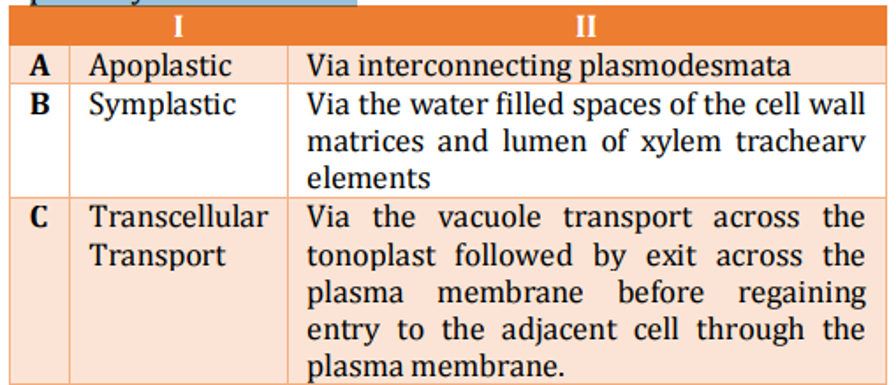
QUESTION ID:5
The Cl content of red blood cells (RBCs) in the venous blood was found to be higher than that in arterial blood in a human subject. Following proposals were made to explain these observations:
A. The high pCO2 in venous plasma leads to increased diffusion of CO2 into RBC and the formation of H2CO3.
B. HCO3 - content in the RBC of venous blood becomes much greater than that in plasma.
C. The excess HCO3 - leaves the RBC of venous blood along with Na+ to plasma by a Na+ - HCO3 -symporter,
D. The increased Na+ in the venous plasma is transported to the RBC along with Cl .
Select the combination with INCORRECT statements from the following options.
QUESTION ID:6
The different waves of normal electrocardiogram (ECG) of a human subject are shown below
The relationship of the events of cardiac cycle to these ECG waves are proposed in the following statements:
A. The P wave occurs due to the depolarization of atria
B. The atrial repolarization is responsible for the T wave
C. The QRS complex occurs during ventricular depolarization
D. Q - T interval indicates plateau portion of auricular action potential
Select the combination with INCORRECT statements from the following options:
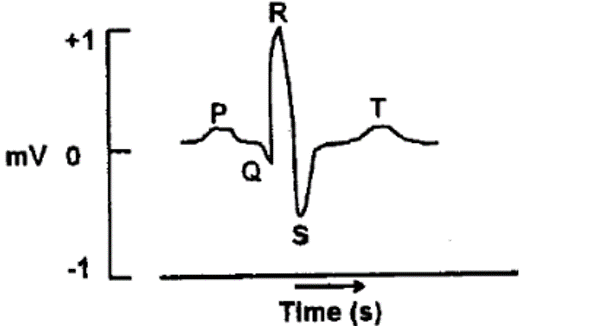
QUESTION ID:7
The excitation of auditory hair cells by the displacement of stereocilia has been explained in the following proposed statements:
QUESTION ID:8
The peaks of the compound action potential (i.e., A, B and C) recorded from a mammalian mixed nerve were affected after application of increasing pressure on the nerve. Some probable changes of compound action are stated below:
A. 'A' peak was inhibited by lower intensity of pressure
B. 'C' peak was inhibited by higher intensity of pressure
C. 'B' peak was inhibited by lower intensity of pressure
D. 'C' peak was inhibited by lower intensity of pressure
E. 'A' peak was inhibited by higher intensity of pressure
Select the option with the combination of CORRECT statements.
QUESTION ID:9
The different segments of renal tubule (column A) and the mechanism of Na+ transport in the apical membrane of tubular cells (column B) are tabulated below: Select the option with the correct matches:
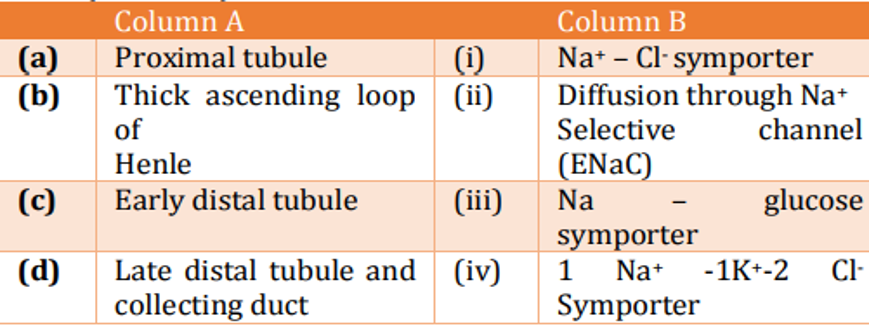
QUESTION ID:10
The figure below represents normal sex determination, differentiation and development in humans Identify A, B, C and D.
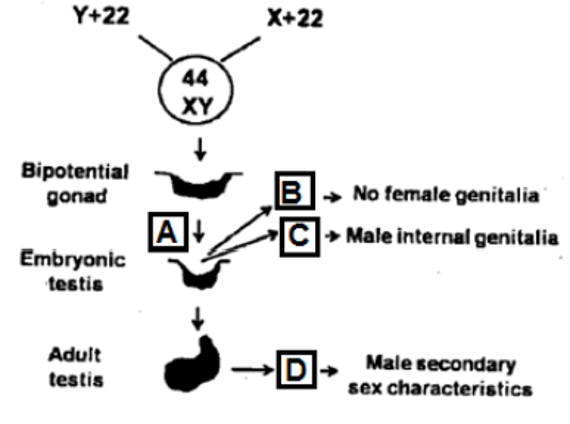
QUESTION ID:11
A virgin Drosophila female was crossed with a wild type male. The F1 progeny obtained had four types of males as shown below
Assuming that white eye and crossveinless mutations are Xlinked and recessive, the following statements were made:
A. F1 females were also of four types as that of males.
B. The white eyed crossveinless male flies appeared due to independent assortment.
C. The map distance between the genes for white eye and crossveinless is estimated to be 12 cM.
D. The map distance between white eye and crossveinless is estimated to be 6 cM.
E. All F1 females are expected to be wild type.
F. The F1 wild type males appeared due to crossing over.
The combination with correct statements is:

QUESTION ID:12
The locations of five overlapping deletions have been mapped to a Drosophila chromosome as shown below (Horizontal lines in the above figure indicate the deleted regions) Recessive mutations a, b, c, d and e are known to be located within this region, but the order of mutations on the chromosome is not known. When the flies homozygous for the recessive mutations are crossed with flies homozygous for the deletions, the following results are obtained (letter "m" represents mutant phenotype and "+'' represents the wild type)
On the basis of the above data, the relative order of the five mutant genes on the chromosome is
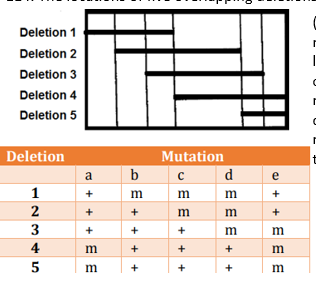
QUESTION ID:13
The pedigree given below follows the inheritance pattern of a late-onset (after age of 30 years) genetic disease that is 100% penetrant. Affected individuals are indicated by a solid circle (woman) or solid ·square (males). RFLP analysis of DNA from each individual is shown below in the pedigree.
Which grandchildren (IIIb to IIId) will be affected by the disease after attaining the age of 30 years?
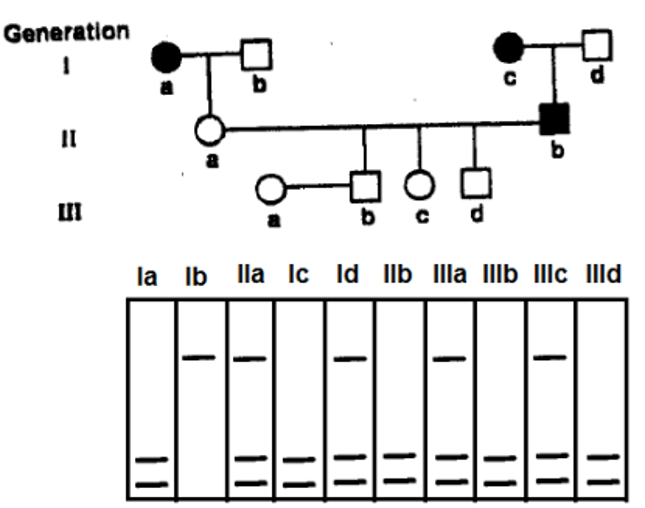
QUESTION ID:14
A chemist synthesizes three new chemical compounds in the laboratory and names them as X, Y and Z. After analysing mutagenic potential of all these compounds, the geneticist observed that all are highly mutagenic. The geneticist also tested the potential of mutations induced by these compounds to be reversed by other known mutagens and obtained the following results
Assuming that X, Y and Z caused any of the three types of mutations, transition, transversion or single base deletion, what conclusions can you make about the nature of mutations produced by these compounds?

QUESTION ID:15
An individual is having an inversion in heterozygous condition. The regions on normal chromosome are marked as A, B, C, D, E, F, G while the chromosome having inversion has the regions as a, b, e, d, c, f, g. The diagram given below shows pairing of these two homologous chromosomes during meiosis and the site of a crossing over is indicated:
The following statements are given to describe the inversion and the consequence of crossing over shown in the above diagram:
A. This is a pericentric inversion
B. This will generate a dicentric and an acentric chromosome following separation of chromosomes after crossing over
C. This will generate two monocentric recombinant chromosomes following separation of chromosomes after crossing over
D. All the gametes thus formed will have deletion and/or duplication and will be non-viable
E. 50% of the gametes having recombinant chromatid will be non-viable, while 50% gametes having non-recombinant chromatid will survive
F. This is a paracentric inversion
Which combination of the above statements describe the inversion and meiotic consequences correctly
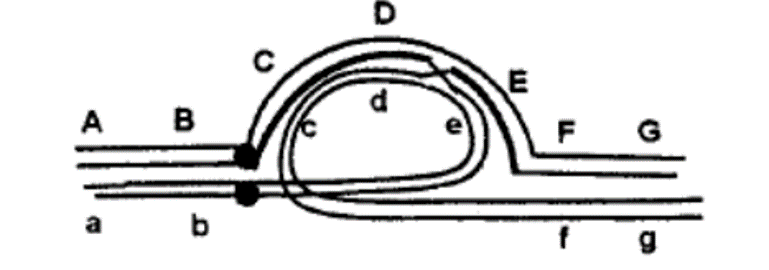
QUESTION ID:16
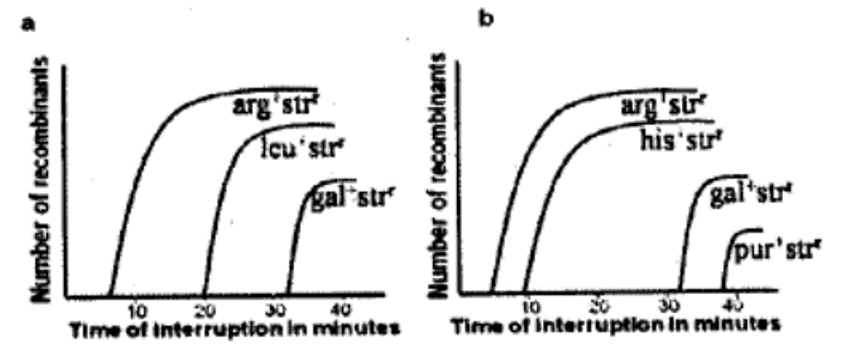




QUESTION ID:17
Three anatomical characteristics (A, B and C) of invertebrate nervous system are used to build a generalized cladogram given below. Presence of the anatomical character is indicated by '+'
Based on the pattern of character distribution, pick the correct combination that are represented by A, B and C
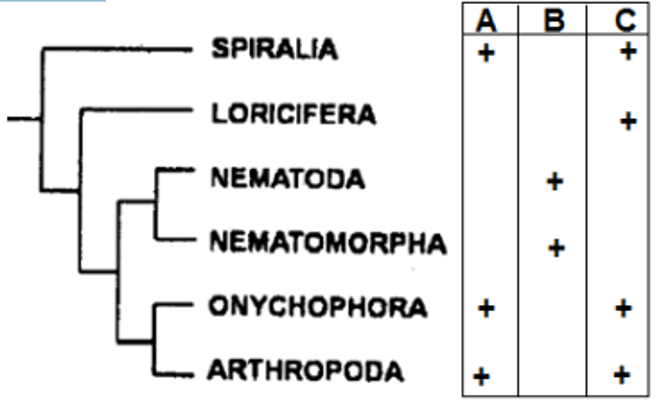
QUESTION ID:18
In order to survive in a non-aquatic environment, plants acquired several adaptations with specialized functions. Given below is a list of features/characteristics (Column A) and their potential role (Column B).
Which one of the following options represents a correct match between the adaptations and their functions?

QUESTION ID:19
Following table presents bryophyte phyla with their selected characteristics: In the above table, phyla A, B and C represent
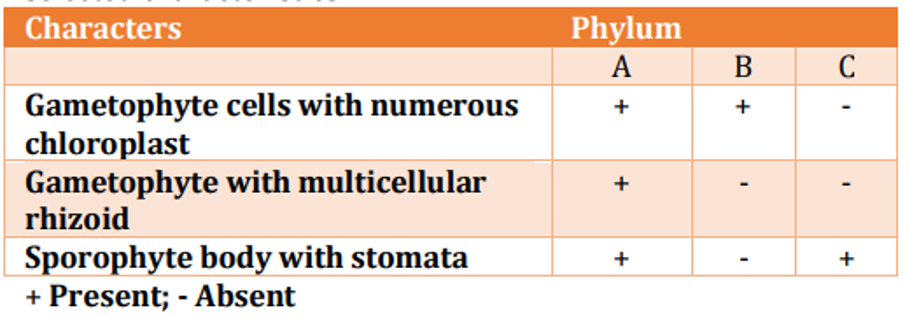
QUESTION ID:20
Following table shows a list of clades and plants: Which one of the following is a correct match for the above?

QUESTION ID:21
The following table shows names of bones (Column A) and specific features (Column B). Which one of the following options gives the correct match of the bones with their specific features?

QUESTION ID:22
The figure below shows the nervous system of Mollusca with ganglia and the connecting nerves. The connecting nerves are labelled as A, B, C and D. Which one of the following options has correct labelling of A, B, C and D?
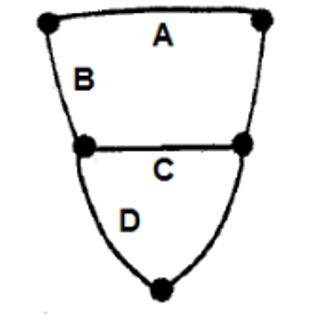
QUESTION ID:23
Following are certain statements regarding energy efficiencies of ectotherms and endotherms:
A. Ectotherms have high assimilation efficiency but low production efficiency.
B. Ectotherms have low assimilation efficiency but high production efficiency.
C. Endotherms have high assimilation efficiency but low production efficiency.
D. Endotherms have low assimilation efficiency but high production efficiency.
Which one of the following represents the combination of correct statements?
QUESTION ID:24
Given below are some properties related to botanical and zoological nomenclature.
A. Absence of tautonyms
B. Presence of genus and species ranks only
C. Absence of principle of coordination
D. Presence of only holotype and neotype
Select the correct combination that distinguishes botanical nomenclature from zoological nomenclature system.
QUESTION ID:25
Following table gives a list of international environmental agreements and areas covered. Which of the following is correct combination?
QUESTION ID:26
The following figure is a "risk-graph" that illustrates the percent risk a species faces towards extinction The following are ranks assigned according to IUCN's red-list category:
(i) Critically endangered
(ii) Near threatened
(iii) Vulnerable
(iv) Least concern
Which one of the following is the most appropriate match between the percent-risk and their assigned rank?
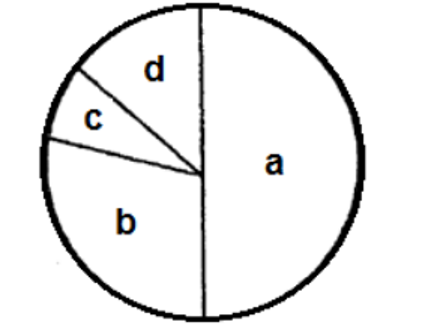
QUESTION ID:27
The complexity of a food web in a community is quantified using certain parameters which are defined below. Which of the following is an INCORRECT representation?




QUESTION ID:28
The above graph illustrates two lines that represent the immigration and extinction rates for an island based on its distance from mainland (solid line) and its size (dotted line). Which of the following is true for this island?
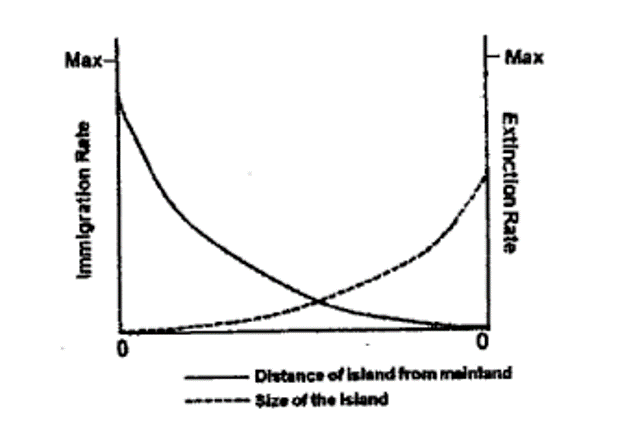
QUESTION ID:29
Inclusive fitness of an animal can be measured as a sum of direct fitness and indirect fitness. Imagine you have 10 off springs. Through diligent parental care, 5 survive to reproduce. You give your life in a heroic deed to save a total of 5 of your nieces and nephews. What is your inclusive fitness?
QUESTION ID:30
Altruism describes a behaviour performed by animals that may be disadvantageous to self while benefitting others. Which one of the following statements is INCORRECT about altruism?
QUESTION ID:31
Given are some statements with reference to the use of genes in plant molecular systematics.
A. mtDNA are not preferred over cpDNA or rDNA because they generally show slow rate of sequence evolution and fast rate of structural evolution.
B. cpDNA are not preferred because of their haploidy, uniparental inheritance, and absence of recombination among cpDNA molecules.
C. rDNA such as ITS are preferred for their higher evolutionary rates as well as shorter sequence length.
D. rDNA and cpDNA cannot be used simultaneously in molecular systematics since they represent conflicting patterns of inheritance.
Which of the above statements are INCORRECT?
QUESTION ID:32
Following are key points about the effect of genetic drift:
A. Genetic drift is significant in small populations.
B. Genetic drift can cause allele frequencies to change in a predirected way.
C. Genetic drift can lead to a loss of genetic variation within populations.
D. Genetic drift can cause harmful alleles to become fixed.
Which one of the following combination of the above statements are true?
QUESTION ID:33
Following table contains some of the generalizations of evolutionary biology: Which of the following is correct match between Column I and II?
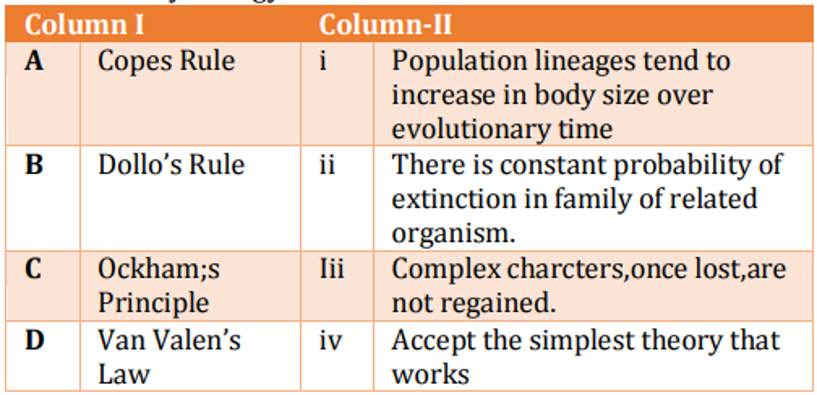
QUESTION ID:34
A 1257 bp genomic DNA sequence of a prokaryotic gene was cloned under a strong constitutive promoter along with a suitable polyA signal and used for development of transgenic tobacco plants. Molecular analysis revealed the presence of three types/lengths of transgene derived mRNAs: 555 bp, 981 bp and 1257 bp - in the leaves of transgenic plants. The following statements were proposed to explain the above results.
A. The three mRNAs represent alternatively spliced transcripts due to the presence of putative intronic sequence in the gene.
B. The gene sequence was characterized by the presence of potential polyadenylation signals that resulted in premature termination of transcription.
C. Expression of full-length transcripts (1257 bases) was lethal to the transformed cells.
D. The transgenic plants were chimeric in nature and comprised of a mix of transformed and untransformed cells.
Which of the following combinations of the above statements would correctly explain the obtained results?
QUESTION ID:35
In order to detect minor variations in antigen concentration, the following procedures were suggested. Which one will likely be the best option?
QUESTION ID:36
Three students (P, Q, R) in a research lab were trying to identify proteins that interact with a transcription factor X. P performed gel filtration experiments and identified that X was found along with proteins A, B, C and D. Q performed coimmunoprecipitation experiments using antibodies to X and identified A, B and C. R did a yeast-2-hybrid screen and identified only B.
The following are likely conclusions that may explain all the results:
(i) A, B, C and D are in a complex with X.
(ii) X directly interacts with B.
(iii) Only A, Band C are in complex with X.
(iv) D is probably weakly associated with X.
Which of the above conclusions best explains all the results?
QUESTION ID:37
Sub-cellular fractionation-based assays have been used to identify various organelles in the mammalian cells. In order to characterize such organelles in a living mammalian cell, which of the following microscopy-based method would be the most accurate?
QUESTION ID:38
From the following statements,
A. Surface plasmon resonance can be used to determine binding constants only in the range of 102 - 103 M.
B. de novo sequencing is not possible by mass spectral methods.
C. The position of hydrogen atoms in proteins is not directly determined by X-ray, diffraction.
D. Circular dichroism and nuclear magnetic resonance spectroscopy do not give the same information on protein structure.
Choose the option with all correct statements.
QUESTION ID:39
A researcher attempted to clone two genes (X and Y) independently in a plasmid vector for over expression and purification in E. coli. All attempts to clone gene X were unsuccessful whereas gene 'Y' could be cloned easily. When the, researcher attempted to clone gene 'X' in the plasmid clone containing gene 'Y', gene 'X' could be cloned. The following statements were proposed to explain the above results.
A. Protein encoded by gene 'Y' is not lethal to the cell.
B. Gene 'X' has introns, which prevents its expression in E. coli
C. Expression of 'X' protein is lethal to the cell.
D. The 'Y' gene product inhibits the activity of 'X' protein
Which one of the following options represents a combination of correct statements to explain the observations?
QUESTION ID:40
In order to visualize the intracellular organization of a cell, one can utilize various microscopy-based techniques. These include:
A. Differential interference contrast (DIC) microscopy
B. Phase contrast microscopy
C. Dark field microscopy
D. Epifluorescence microscopy
E. Scanning electron microscopy
F. Transmission electron microscopy
G. Confocal microscopy
Which of the above mentioned microscopes can be used to study the intracellular dynamics using live cell imaging?
QUESTION ID:41
A certain protein has been assumed to play an indispensable role in the survival of an intracellular parasite inside the host cells. Which one of the following techniques will best prove the assumption to be correct?
QUESTION ID:42
Given below is a table with information on isotopes, their half-life and type of particle(s) they emit. Choose the correct combination from the options given below.

QUESTION ID:43
Which one of the following set of essential components are required for Sanger method of DNA sequencing in a required buffer containing MgCl2 and Tris-HCl?
 TLS Online
TLS Online